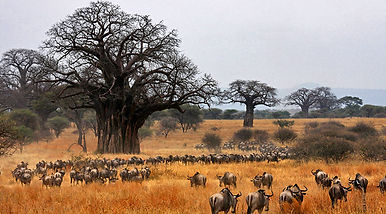
Northern Safaris
Serengeti National Park.
A million wildebeest... each one driven by the same ancient rhythm, fulfi lling its instinctive role in the inescapable cycle of life: a frenzied three-week bout of territorial conquests and mating; survival of the fi ttest as 40km (25 mile) long columns plunge through crocodileinfested waters on the annual exodus north; replenishing the species in a brief population explosion that produces more than 8,000 calves daily before the 1,000 km (600 mile) pilgrimage begins again.


Tarangire National Park.
Day after day of cloudless skies. The fi erce sun sucks the moisture from the landscape, baking the earth a dusty red, the withered grass as brittle as straw. The Tarangire River has shrivelled to a shadow of its wet season self. But it is choked with wildlife. Thirsty nomads have wandered hundreds of parched kilometres knowing that here, always, there is water.








